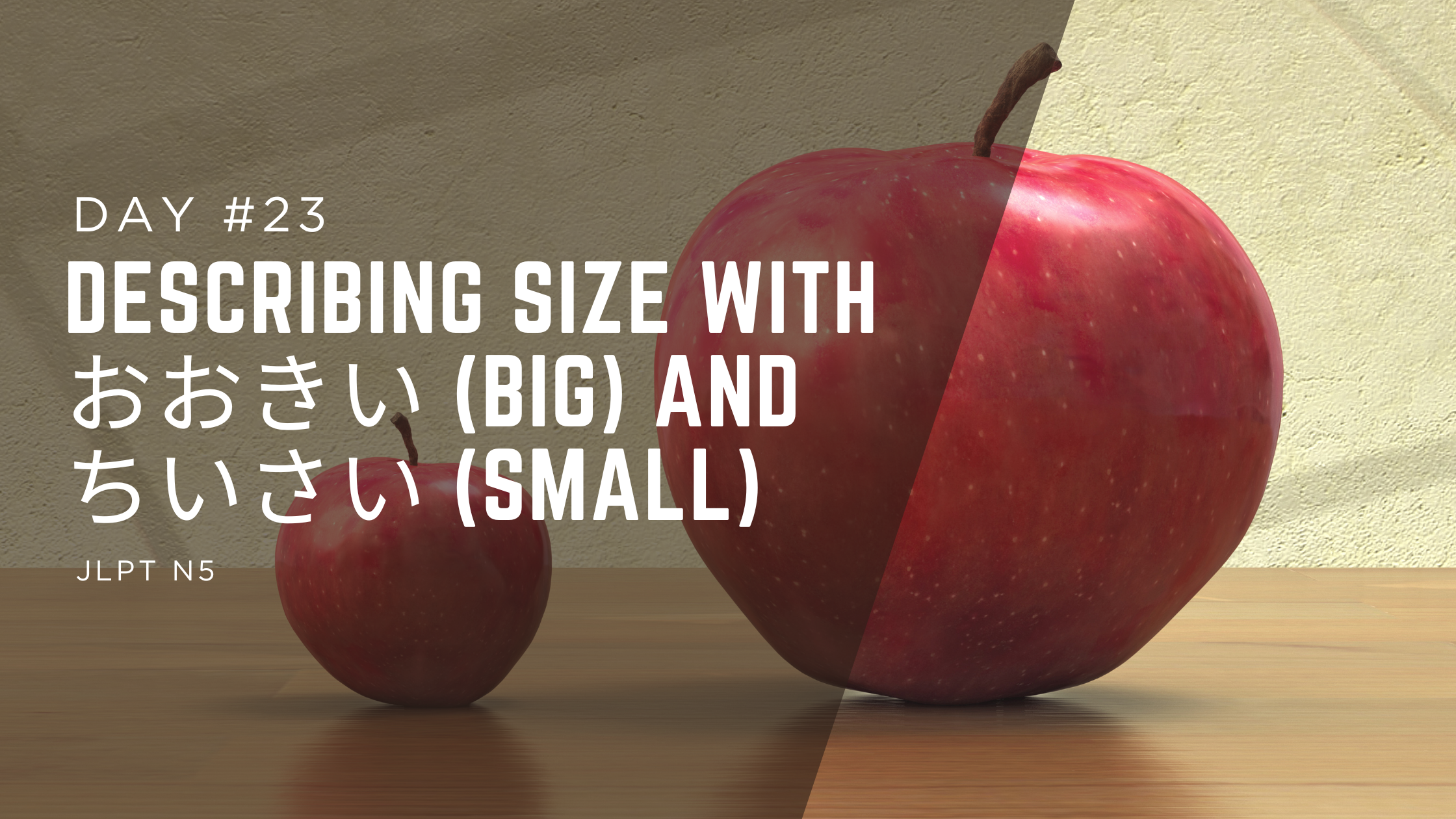Hello! Welcome to Day 23 of Your 100-Day Japanese Challenge!
Congratulations! You’ve reached Day 23 of our 100-day journey to conquer JLPT N5!
Today, we’re focusing on describing size with two key adjectives: おおきい (ookii – big) and ちいさい (chiisai – small).
Imagine describing a “big car” or a “small room” in Japanese – these adjectives will make your conversations vivid and precise.
By the end of this lesson, you’ll confidently describe size, ready for JLPT N5 prep. Let’s dive in!
Why おおきい and ちいさい Are Essential for Beginners
The adjectives おおきい (big) and ちいさい (small) are core JLPT N5 vocabulary.
They let you describe the size of objects, places, or even ideas, adding clarity to your speech. In the JLPT N5 exam, these adjectives appear in reading, listening, and grammar sections, often paired with nouns or です (desu).
Mastering おおきい and ちいさい today builds on your Day 22 skills (using なに/なん) and helps you express observations clearly. Plus, describing size is a practical way to connect with native speakers!
Main Lesson: How to Use おおきい and ちいさい Step-by-Step
Let’s break down おおきい and ちいさい in simple, beginner-friendly steps.
Step 1: Understanding おおきい and ちいさい
Both おおきい (ookii – big) and ちいさい (chiisai – small) are い-adjectives, which end in い and can directly modify nouns or stand alone with です.
Describing a noun: Place the adjective before the noun.
い-adjective + noun
おおきい みせ (ookii mise) – A big store.
ちいさい へや (chiisai heya) – A small room.
Making a sentence: Use は to mark the topic and です for politeness.
Noun + は + い-adjective + です
これ は おおきい です。 (Kore wa ookii desu.) – This is big.
この みせ は ちいさい です。 (Kono mise wa chiisai desu.) – This shop is small.
Step 2: New Vocabulary for Size Descriptions
Here’s a table of new JLPT N5 nouns for Day 23, avoiding previous days’ vocabulary:
| Hiragana | Romaji | English |
|---|---|---|
| へや | heya | Room |
| みせ | mise | Shop |
| かばん | kaban | Bag |
Step 3: Why you can’t say “へや は おおきい”
The word “へや” is a concept, encompassing large rooms, small rooms, medium-sized rooms, and so on.

You can say “この へや は おおきい (This room is big)”. That’s because you’re talking about a specific room by saying “this room.”

But you can’t say “へや は おおきい (A room is big)”. That’s because rooms come in various sizes, and whether they are perceived as large or small depends on the individual.

The same sense applies in English too, doesn’t it?
For example, “a room” doesn’t refer to a specific room, while “the room” is used when the speaker has a particular room in mind.
This isn’t just about “へや,” but keep in mind that Japanese has a similar sense too.
Step 4: Negative Forms
- For い-adjectives, replace い with くない to negate.
- おおきい → おおきく ない (ookiku nai) – Not big.
- ちいさい → ちいさく ない (chiisaku nai) – Not small.
However, it’s better to say “おおきく は ない (ookiku wa nai)” or “ちいさく は ない (chiisaku wa nai)”.
Why “おおきく は ない (ookiku wa nai)” Is Better ?
For Japanese い-adjectives like “おおきい” (ookikii, big), negation is commonly formed by replacing the final い with くない, as in “おおきく ない” (ookiku nai, not big).
However, saying
“この へや は おおきく ない”
(Kono heya wa ookiku nai)
(This room isn’t big)
feels casual and slightly childish due to its direct, emotional tone, often used in informal settings or by children.
In contrast, the structure in
“この へや は おおきく は ない が、わたし は すき です”
(Kono heya wa ookiku wa nai ga, watashi wa suki desu.)
(This room isn’t particularly large, but I like it)
uses the connective form “おおきく” (ōkiku) with “は” to create a nuanced contrast.
The “は ない” (wa nai) construction adds a refined, mature tone, suggesting “it’s not big, but it has other qualities.”
The particle “が” (ga) introduces the positive follow-up “わたし は すき です” (watashi wa suki desu, I like it), emphasizing a balanced, thoughtful sentiment.
This makes the sentence polished and fitting for adult or semi-formal conversations.
Practice Section: Describe Size with Confidence!
Let’s practice おおきい and ちいさい with these exercises for JLPT N5 prep.
Day 23 Quiz: Describing Size with おおきい and ちいさい
1. へや は ____ です。 (The room is big.)
2. Translate to Japanese: “This shop is small.”
3. この いぬ は ____。 (This dog is big.)
4. Translate to English: この かばん は ちいさい です。
5. なに が ____ です か? (What is big?)
6. Translate to Japanese: “This room is not small.”
7. おおきい ____ (A big cat)
8. Translate to English: この みせ は おおきく は ない です。
9. かばん は ____ です。 (The bag is small.)
10. Translate to Japanese: “What is not big?”
Common Mistakes for English Speakers
English speakers often trip up with おおきい and ちいさい.
Here’s how to avoid pitfalls:
- Negation errors:
Use くない, not じゃ ありません for い-adjectives.
Wrong: おおきい じゃ ありません. - Adjective placement:
Don’t add な to い-adjectives.
Wrong: おおきい な へや.
Correct: おおきい へや. - Pronunciation:
おおきい is “oh-kee,” not “oo-kee”;
ちいさい is “chee-sai,” not “chai-sai.”
Conclusion: Size Up Your Japanese!
Today, you learned to describe size with おおきい (big) and ちいさい (small), mastered their grammar, and practiced new vocabulary like へや and みせ.
You’re now ready to describe the size of things in Japanese – how exciting!
Keep up the momentum for JLPT N5 prep.
Tomorrow, join us for Day 24: Talking About Locations with どこ (Doko) – Where Is It? to explore places in Japanese.
Loved this lesson? Subscribe to our newsletter for daily tips and resources to ace your Japanese learning. Share a sentence with おおきい or ちいさい in the comments – what’s something big or small around you? See you tomorrow!



